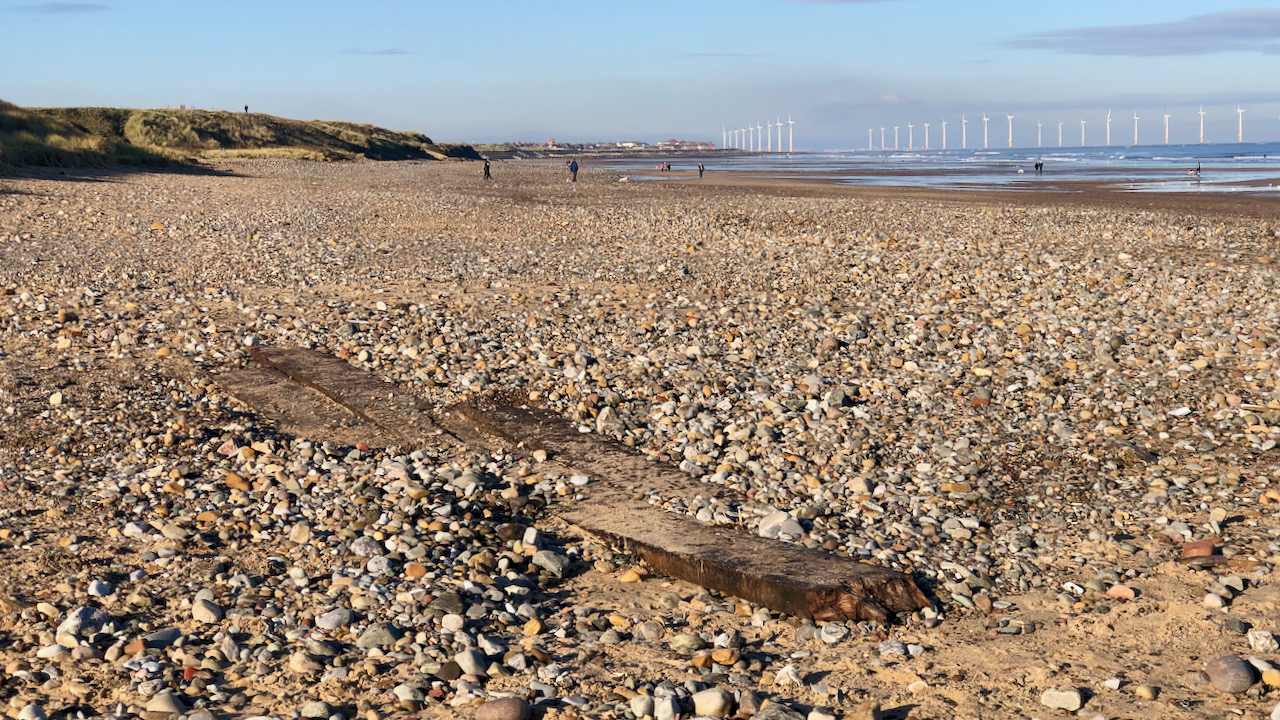One of my particular aversions is walking, or running, along a beach, a seemingly endless repetition, a far-off point on the horizon never drawing closer.
Yet, it was deemed worthwhile to undertake this stomp in order to see the substantial remains of a wooden sailing vessel cast ashore in the aftermath of Storm Babet. The outcome proved disappointing. Merely a handful of planks remained. A link to a photo taken by ‘The Smell of Water‘ website is necessary to show the spectacle that has eluded me.

But where has the rest gone? Souvenir hunters? Reclaimed by the sea? Entombed beneath the shifting sands? Or maybe we were just in the wrong place.
The opinion is that the wreckage is from the Whitby whaler, the Esk, which met its watery demise off the rocky scars of Marske on a blustery September morn in the year 1826. A tale of nautical misadventure, it was for sure. The vessel, a sturdy 350-ton creation, had weathered the whims of the sea for a good spell, built in 1813 and bearing the ownership of Broderick, Fishburn, and Company of Whitby.
Now, the captain of this seafaring enterprise was none other than William Scoresby Junior, a lad of twenty-three at the helm, who had already etched his name in local maritime history. The year 1816 marked his fourth Greenland voyage aboard the Esk, and little did he fathom the trials awaiting.
The Arctic expanse proved no friend to the Esk. Rudder damaged by encroaching ice, yet Scoresby persisted in the icy hunt for whales. May saw the Esk ensnared again, ice gripping her tight. Whaling brethren rallied, but the ship’s hold told a tale of impending doom—eight and a half feet of water, a watery spectre.
Scoresby, not one for hasty surrender, pondered an unconventional solution. Let the Esk fill, then tilt her over, exposing the damaged hull. A risky gambit, to be sure. Unload the stores, anchors suspended, men at the lines, but the Esk, stubborn as the sea itself, refused to tilt over, prevented by a protruding piece of the keel.
Ignoring the naysayers, Scoresby’s crew tore away the offending keel, patched her up with canvas and oakum, and set sail for Shetland in tow of another whaler, the John. A saga of mishaps followed—’fothering‘ torn asunder, stern post loosened, and relentless seas forever threatening to send the Esk to the abyss.
After Herculean efforts, Scoresby and his beleaguered crew glimpsed the shores of Shetland, a beacon of salvation. The Esk, battered but not broken, limped into Lerwick, a testament to tenacity.
Yet, the Esk’s maritime odyssey continued, a brief respite before setting sail once more. Captain Dunbar took the helm, but fate, cruel mistress, intervened on a fateful September day in 1826. A southerly breeze turned vicious, sails shredded, and the Esk, at the mercy of an easterly gale, found herself driven shoreward.
In the inky darkness, desperate attempts to save her proved futile. Floundering off Marske, the Esk succumbed to the relentless assault of wind and wave, shattered into the unforgiving scars at 5:15 am on that mournful morning.
Scoresby became a preacher and later paid homage to the fallen vessel in a memorial service that drew 3,000 souls to Whitby’s St. Mary’s Church. A tale of tragedy and resilience, the Esk’s demise left but three survivors amidst the wreckage, a stark reminder of the capricious mistress that is the sea.
Further reading
- ‘Story of the Esk | My Site 28780’. 2016. <https://www.chrisscottwilson.co.uk/StoryOfTheEsk> [accessed 17 November 2023]
- ‘Esk | Heritage Gateway ’. <https://www.heritagegateway.org.uk/Gateway/Results_Single.aspx?uid=937642&resourceID=19191> [accessed 17 November 2023]

Leave a Reply